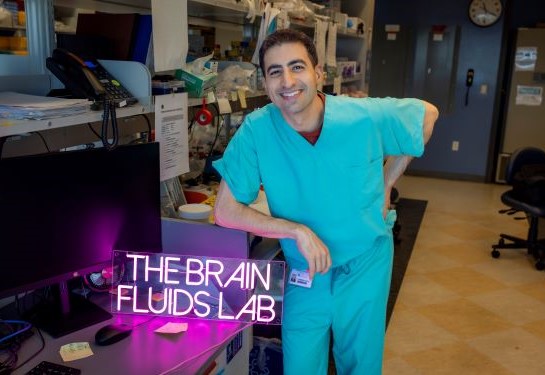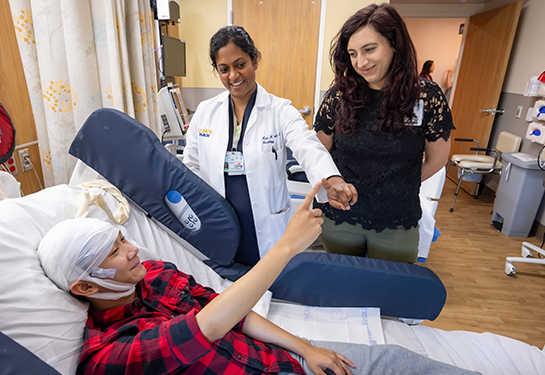Focusing on brain injury prevention during awareness month
Brain injury is a leading cause of death and disability
March is Brain Injury Awareness Month, serving as a reminder to focus on the prevention of brain injuries where possible, and to spread awareness of people living with brain injuries. This is especially important for young people ages 15-24, children under the age of 5 and adults over 75, who sustain most of the brain injuries reported in the United States.
An estimated 5.3 million Americans live with long-term disabilities as a result of brain injury.
Brain injuries are also a leading cause of death and disability and account for at least a million emergency department visits per year.
We checked with Ryan Martin, a UC Davis Health associate professor of neurological surgery and neurology, to learn more about brain injuries and prevention strategies.
What is a brain injury?
There are different types of brain injuries.
Acquired brain injuries are those that are not hereditary, congenital, degenerative, or induced by birth trauma. They can be either traumatic or non-traumatic.
Traumatic brain injuries, or TBIs, involve trauma to the brain from an external force, such as during a fall. Non-traumatic brain injuries are caused by stroke, seizure, oxygen deprivation, tumor and substance use.
“Traumatic brain injury is an epidemic that affects millions worldwide, leading to significant mortality and disability,” Martin said. “Prevention of TBI is imperative through easy and thoughtful interventions to prevent harm and lasting neurological injury.”
Brain injuries, including concussions, are extremely serious and require immediate evaluation by a provider who has experience assessing head injuries. An experienced provider can perform a neurological exam to judge motor and sensory skills. They can also test hearing and speech, coordination and balance, mental status, and changes in mood or behavior.
At UC Davis, we are committed with a multidisciplinary team to improve outcomes following traumatic brain injury. In both the hospital and clinic settings, we will work with you and your family on a path towards recovery and return towards normalcy. We will be with you the entire way."—Ryan Martin
Common symptoms of a brain injury
Martin says immediate medical attention is critical with a brain injury, especially if any of the following symptoms are present:
- Loss of consciousness
- Headache
- Confusion
- Difficulty talking like slurred speech
- Inappropriate emotional responses
- Blurred vision
- Problems with balance and walking
- Poor coordination
- Vomiting
- Lethargy
- Slow pulse
- Slow breathing
- Memory problems
"At UC Davis, we are committed with a multidisciplinary team to improve outcomes following traumatic brain injury,” Martin said. “In both the hospital and clinic settings, we will work with you and your family on a path towards recovery and return towards normalcy. Recovery time varies by patient and injury, and we will be with you the entire way."
The departments of Neurology and Neurosurgery work with the Department of Physical Medicine and Rehabilitation (PM&R) for continuity of care for patients who have experienced brain injury. PM&R leads inpatient rehabilitation of patients, and all three departments work together to get patients back to their healthy and active lifestyle.
Who is most at risk for brain injuries?
A brain injury can happen to anyone, but most brain injuries occur in people ages 15-19. Children under 5 and adults over 75 are also at higher risk due to falls. Men are nearly twice as likely to be hospitalized and three times more likely to die from a brain injury than women.
Among children under 14, brain injury leads to an estimated 2,685 deaths, 37,000 hospitalizations, and 435,000 emergency department visits annually in the U.S.
One of every 60 people in the U.S. lives with a brain injury-related disability.

Avoiding brain injury for people of all ages
The best strategy is taking steps to reduce your chances of a brain injury. Martin and other experts share this valuable advice:
- Ensure that children play in playgrounds made of shock-absorbing material, such as hardwood mulch or sand
- Install stair gates and window guardrails in homes with young children
- Wear a properly fitting helmet when riding a bike or playing football, hockey, snow sports, skating or skateboarding
- Always wear a seatbelt
- Don’t drive under the influence of alcohol or drugs
- Improve lighting and eliminate trip hazards in the home or workspace
- Use nonslip mats and install grab bars next to the toilet and in the tub or shower for older adults
- Install handrails on stairways
- Improve balance and strength with regular physical activity
“Simple interventions, like wearing a helmet and using handrails while on stairs, can really go a long way to minimize your chances of developing a traumatic brain injury.”
UC Davis Health’s Department of Neurology and Neurosurgery is dedicated to providing care for patients who have suffered serious brain injury. Neurologists, neuropsychologists, and research scientists work together to improve patient care through research and education. Visit the department’s website to learn more.
Related resources
- The Brain Injury Association of America website






